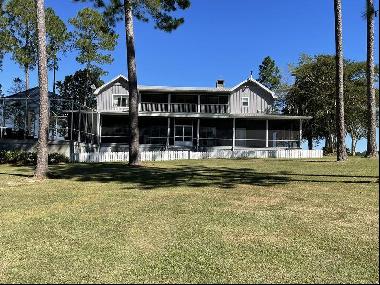
By Anthony Paletta
Frank Lloyd Wright made no secret of his distaste for cities. “A parasite of the spirit is here, a whirling dervish in a whirling vortex,” he wrote in The Disappearing City, his 1932 treatise on the American metropolis. His grand unbuilt scheme, Broadacre City, sought to dissolve the city, integrating agriculture into conventional urban spaces.
And yet Wright designed only a handful of homes that could accurately be described as farmhouses. One of these is in California’s fertile Central Valley, sandwiched between the mountains of the Coast Ranges and the Sierra Nevada. Designed for Harriet and Randall “Buck” Fawcett in 1955, it was one of Wright’s final residential commissions and only completed in 1961, two years after his death. The property remains in strikingly good shape, thanks in part to the quality of its design and construction and in part to a recent revamp by its current owners, Carrie and Ken Cox, who bought it from the Fawcetts in 2012.

A crucial selling point for the Coxes was the house’s agrarian surroundings, which remain virtually the same as in 1961, with no high-rise buildings or power lines to spoil the view. The land around the property is still used as a working farm. “We don't do the work but we get to experience the beauty,” Carrie says, explaining how the seven-bedroom home, which is currently on the market for $4.25mn, was designed to maximise these views: Wright’s U-shaped plan features two wings, one fronted nearly entirely with windows on one side. The other wing is more private, consisting largely of concrete block walls and clerestory windows.
“The context of the house is virtually intact,” says Carrie. “It is amazing to find a house this age that’s original both in itself and in the environment in which it resides.” The couple discovered the property after attending a conference on Wright’s work at his Fallingwater home in Bear Run, Pennsylvania, where they subsequently developed a habit of avidly browsing the For Sale section of the Wright conservancy website. “It [the house] needed a lot of restoration but it hadn't been hacked up or changed. That’s what clinched the deal for us.”

The Coxes’ approach treads a fine line between respecting the integrity of the original designs and avoiding living in a home with Eisenhower-era appliances. Original drawings and blueprints were a help, as was expert advice from Arthur Dyson, an architect and apprentice with Wright (as well as input from Wright’s grandson, Eric Lloyd Wright).
Dyson encouraged the couple not to feel that they needed to preserve every inch of the property. He told the Coxes that one of his first tasks as an apprentice — at Wright’s direction — was removing and replacing old lighting at Wright’s studio and home in Arizona. The Coxes also met architect Cornelia Brierly, who worked with Wright on the home’s interior design. Carrie says that Brierly quipped, “Why would you want all that old stuff?”
In some ways, the Coxes’ restoration can be considered closer to Frank Lloyd Wright’s original vision than the structure built in 1961. Early plans included a fireplace in the master bedroom that was never constructed, so they had it built. This was no simple task — the fireplace is effectively corbelled, with bricks protruding over one another. It required two tries to get right. They also added a forecourt that Wright had designed but was also never built.

The interior of the property is defined by the use of diagonals, which was a revelation to Carrie. “We all live in right-angled houses, there are corners around us everywhere — you don’t even notice them — but once you spend time in a house that doesn’t have hard-angled corners, it just alters the sense of the home. It creates this incredible sense of peace and flow throughout the whole house.”
Carrie singles out the master bedroom for praise. “Wright is famous for these seamless corner windows. You feel like you are outside; it’s as close to camping as you can come and still be indoors.”
Having decided to sell, the Coxes believe they are leaving the home in the best condition for its next steward. “It captured our hearts and we wanted to bring it back to life,” says Carrie. “We hope we have restored the house to its original beauty.”
Photography: Crosby Doe Associates





















